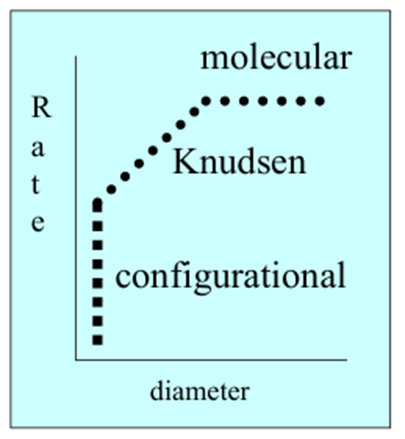Heterogeneous Transformations
1/33
There's no tags or description
Looks like no tags are added yet.
Name | Mastery | Learn | Test | Matching | Spaced |
|---|
No study sessions yet.
34 Terms
What are the benefits of a heterogeneous catalyst?
Ease of separation
Easier use in flow reactors (more efficient, safer, higher ratio of catalyst to reagents)
Shape selectivity (pore size)
What is the benefit of catalysts with multiple surface sites?
You can have different properties in different areas of the catalyst surface eg hydrophilic/ hydrophobic, bronsted acid, amphoteric sites (both acidic and basic), lewis acidic.
What is the IUPAC definition of
A) Micropores
B) Mesopores
C) Macropores
A) < 2.0 nm
B) 2-50 nm
C) > 50 nm
What is the benefit of pores in a catalyst?
Increased surface area so more active sites
Define heterogenisation
Attaching a homogeneous catalyst to a solid surface.
What is the role of (MeO)3SiR in heterogenisation?
Adds an organic group to an inorganic support.
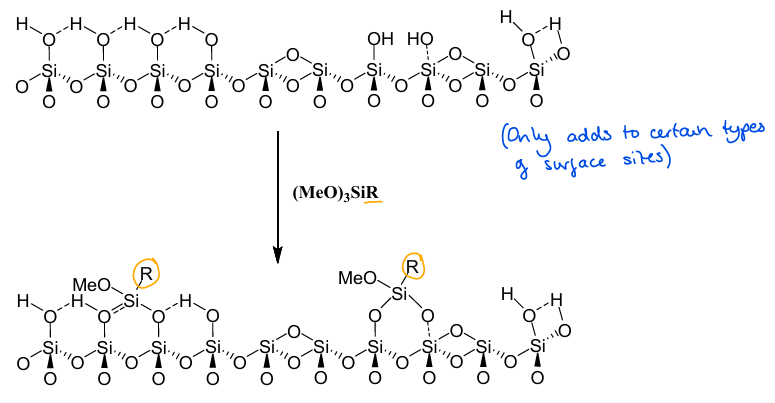
What are the two methods of heterogenisation?
1) Grafting to the surface with (MeO)3SiR
2) Direct synthesis of catalytic groups into the support
What are the benefits of solid sulphonic acid?
High loading (2-3 mmolg-1)
Bronsted acidity
High surface area
Ease of separation as heterogeneous catalyst
Recyclable with no loss of activity
What are the disadvantages of solid sulphonic acid?
Catalyst formation has production steps which increases the PMI of the process (more waste produced)
What are the disadvantages to using AlCl3 in Friedel Crafts reactions?
Produces very acidic waste and is too reactive to be recovered.
What are the benefits of using solid supported AlCl3 in Friedel Craft reactions?
No toxic aqueous waste produced
Faster and simpler process
Lower excess of benzene required
Lower PMI
Catalyst is reusable
What is shape selectivity
When the size of the pore dictates which products are favoured. Eg smaller pore means less di-substituted products
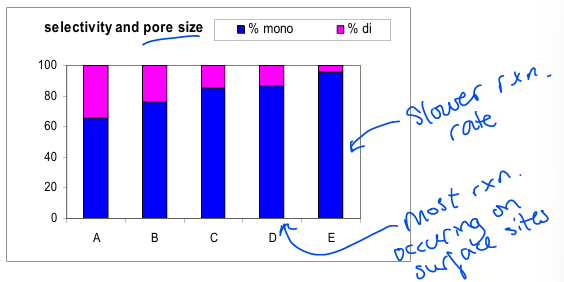
Why is a catalyst required for amide formation? Which catalyst is used?
The traditional (non-catalysed) method involves heating acid and amines together. This requires an activating agent (such as SOCl2) which is rarely recoverable.
Silica is used because it makes the process safer (less toxic than SOCl2 etc.), is reusable and is easily removed
What are the benefits of flow chemistry?
Good temperature control (higher surface area)
Smaller reaction volumes so smaller accidents
Larger catalyst to reagent ratio
Good mixing
Once the flow begins, it is low maintenance
Unreacted reagents can be cycled back around
What is the general make-up of zeolites?
SiO2 framework, with some Si replaced with Al.
Al isomorphous substitution gives acidity.
The lattice has an overall negative charge so requires counterions.
What is the aperture diameter?
The size of the pore entrance.
What is the typical aperture diameter of a zeolite pore?
< 1 nm
generally just large enough for small aromatic molecules
What are the disadvantages to zeolite synthesis?
High temp. and moderate pressure
NaX (sodium salt) waste
Template is burned out, meaning poor AE & PMI
What are the advantages to zeolite synthesis?
Zeolites are almost indestructible so last for several years - high TON - synthesis negatives are outweighed
What are the two types of zeolite structure?
Pentasil and truncated octahedron
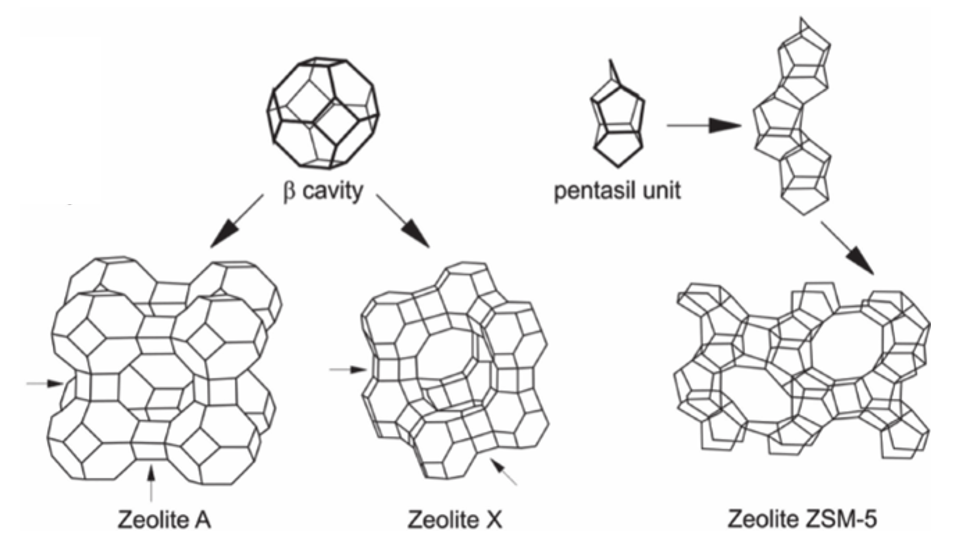
Name this zeolite structure
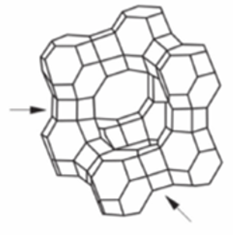
Faujasite
What is the impact of replacing a Si with Al in a zeolite?
Al gives a framework charge of -1 so a positive counterion is required. This is typically Na from the synthesis, which can then be replaced with Ca/ Mg etc to soften water
What impact does the positive counterion have on a zeolite?
Can impact pore size
How do you produce a zeolite with a H+ counterion?
Add NH4Cl to introduce a NH4+ counterion, then reflux to remove ammonia
How do you measure the acid strength and concentration of acid sties of a zeolite?
Measure Tdes (temp. of desorption) - a higher temperature means a stronger acid site
The amount of ammonia released suggests the number of acid sites
This is called temperature-programmed desorption (TPD)
What is the relationship between Al content and the strength of the acidic sites?
More Al means weaker acidic sites, but more of them
What is the term for the acidity level when there’s few Al sites?
Superacidic
How does Tdes in the desorption of ammonia from a zeolite (TPD) dictate the acidity?
A higher Tdes (temp of desorption) indicates a more acidic zeolite
What is the main application of zeolites?
Cracking of crude oil
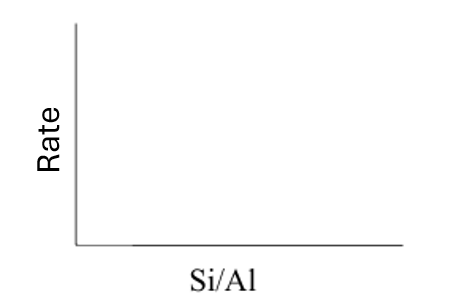
What is the general shape of this graph?
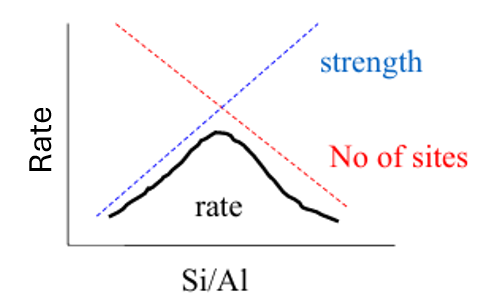
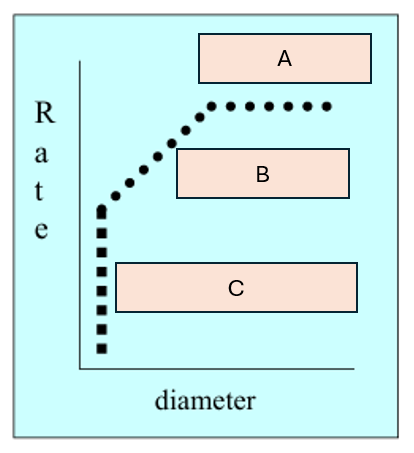
What is behind boxes A-C
A) Molecular
B) Knudsen
C) Configurational
Describe molecular diffusion
When the pores are much larger than the molecule so diffusion rate is constant with increasing pore size
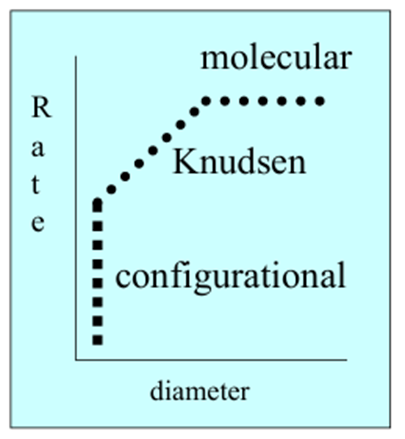
Describe Kudsen diffusion
When pores are sightly larger than the molecules so diffusion rate increases proportionally with pore size
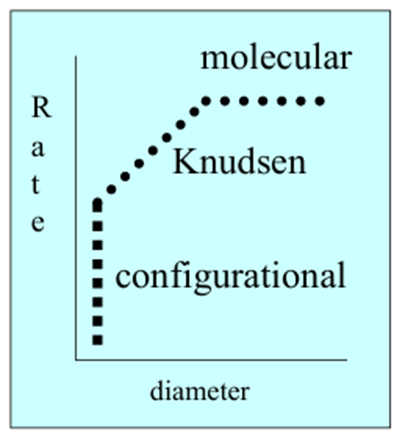
Describe configurational diffusion
When the pores are similar in size to the molecules so the diffusion rate is determined by the orientation of the molecules
